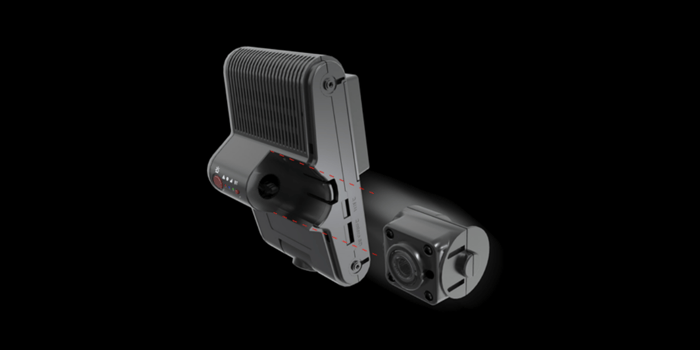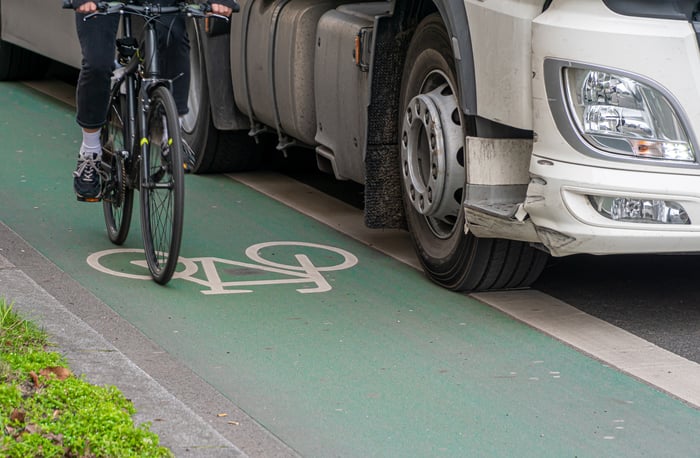
Table of Contents
As the world of commercial fleet safety continues to evolve, so must we.
At DiCAN we are constantly looking for new ways to help you protect and manage your commercial vehicles. One of our latest commercial fleet safety solutions is the Sensata Insights (formerly SmartWitness) KP2 Modular Dash Camera. This innovative dashcam offers commercial vehicle fleets the ultimate flexibility in video telematics.
From small businesses with a handful of drivers to large enterprises with hundreds, this road-facing camera and optional driver-facing camera provide fleets with the adaptability they need to protect their employees and property. In today’s blog, we’ll provide a complete overview of this ground-breaking product and how it can improve fleet safety. But before we delve into that, let’s take a brief look at just how far dashcams have come.
How it all began: The Evolution of Fleet Dashcams
With today’s modern dashcams, you’d be hard-pressed to tell the difference between real life and film. The cameras are now equipped with 1080P HD cameras, wide-angle views, and real-time GPS tracking. But this wasn’t always the case. Fleet dashcams have come a long way since their inception.
The first recorded use of a dashcam can be traced all the way back to the 1930s when H.C. Fairchild of Washington DC invented the first-ever “windshield camera” to assist local law enforcement in catching traffic perpetrators. With three cameras mounted to the vehicle, the device captured still photos while recording the date and time in an effort to combat traffic violations. Three decades later in the 1960s, dash cameras became more standard in police vehicles and were utilized in several states across North America.
From Still Images to Video Footage: 1980s and 1990s
Fast forward to the late 1980s and early 1990s, and dash cameras really began to take off. Thanks to advancements in technology, officers no longer had to rely solely on still images. Dashcams were finally able to record video footage of traffic violations and accidents for evidence.
In 1988, Detective Bob Surgenor was recognized for recording a high-speed pursuit from beginning to end using a dashcam. Many accredit this capture to the outburst of popular dashcam footage featured in many popular television shows seen in the 90s.
At this point, dashcams were still exclusively targeted toward police vehicles. And although they seemed to be making many advancements, these large and bulky dash cams were still far from the cameras we use today.
Held up by tripods, these early models utilized analog technology, which means their recordings were not saved digitally, but instead were recorded on VHS cassettes– remember those? As you can only imagine, this made transferring and storing recordings incredibly time-consuming. The resulting video quality was also not great, making it extremely difficult for officers to identify license plate numbers and other vital information.
Dashcams– More Than Just a Law Enforcement Tool: 2000s to Today
Despite the American origins of the dashcam, Russia was heavily involved in popularizing the technology. In fact, the Russian government allowed and even encouraged drivers to install dashcams to combat the surge in insurance fraud cases. By 2013, over 1 million Russian drivers reported using at least one dashcam in their vehicles.
Nowadays, however, dashcams have become much more than just a tool used for catching traffic violators and protecting everyday citizens from insurance fraud. Thanks to their high-quality footage and cloud connectivity, they are now an essential part of fleet safety.
With built-in GPS functionality and impressive cloud connectivity, fleet operators can see exactly where an incident occurred and access the footage in mere seconds– no physical memory card required. This speeds up claims processing and minimizes overall costs. It also enables managers to train drivers in real time, correcting any adverse driving behaviours before they even start.
Sensata Insights KP2 Modular Dash Camera
The first of its kind, the Sensata Insights KP2 Modular Dash Camera, is anything but ordinary. The modular dash camera provides the best of both worlds with road and optional driver-facing visibility in one plug-and-play device.
With the revolutionary KP2, fleets of all sizes can effortlessly upgrade their forward-facing dash cameras into two-way units without rewiring or purchasing new hardware, offering fleet managers a cost-effective and flexible option to identify risky driving behaviour and the cause of accidents.
In the past, adding a driver-facing dash camera required purchasing standalone cameras, costing fleets time and money. But thanks to the KP2’s 1”x 1” simple plug-in, all you have to do is snap it into the base unit, eliminating any potential downtime and increasing your fleet’s productivity.
In an effort to provide the ultimate flexibility for fleet safety, driver-facing visibility can be added now, or later– the choice is yours. It takes just seconds to install and doesn’t require any downtime. This means your drivers will never have to worry about being out of work for long. They’ll be able to keep up with the demands of your business– no matter where you are or what’s going on.
Each KP2 Modular Dash Camera includes the well-known cloud-based AI Driving Events (AIDE) software. Long acclaimed for its ability to significantly reduce flawed reports, the algorithm applies a wide range of contextual factors to the video captured by system cameras. Decreasing false positives can save hours of time otherwise spent reviewing false alerts of risky driving behaviour, which oftentimes requires manual review by fleet managers. It also reduces the possibility that drivers are unfairly flagged for safety violations.
Key Features:
- 1080P Full HD 1920 x 1080 Road-Facing Forward-Looking Camera with GPS, EMS, and video telematics
- Optional “Plug and Play” Add-On Infrared 720p HD Interior-Facing Cabin Camera
- 140° Wide Angle Lens
- Offers a choice of real-time ADAS (Automatic Driver Assist System) collision avoidance alerts such as real-time tailgate warning, forward collision warning, and pedestrian collision warning.
- Provides a choice of real-time DSM (Driver State Monitoring) in-cab behaviour detection alerts to help prevent accidents including driver fatigue and distraction, as well as smoking and phone use while driving
- Each KP2 includes the cloud-based AI Driving Events (AIDE) software. Long acclaimed for its ability to greatly reduce inaccurate reports of poor driving behaviour, this feature alone warrants any sized fleet to take note.
- Road-facing HD video camera records and uploads event data directly to the cloud.
- The snap-on driver-facing camera provides instant access to AI-powered driver distraction/fatigue detection and other driver-state monitoring features.
- The plug-and-play design allows for lightning-fast self-installation
- Failsafe technology ensures videos are uploaded during catastrophic events, even in the absence of a satellite.
- Comes FirstNet certified, enabling qualified users to access AT&T’s exclusive emergency cellular network
- 12 Months GPS data retention standard; with SmartPay, standard 9-month event/video data retention extended to 12 months
- 64GB SD card that can store over 50 hours of footage before beginning to overwrite.
4 Reasons Why A Modular Dash Cam is Necessary for Fleet Safety
If you’re the operator of a commercial vehicle fleet, you know that safety is paramount. But how do you ensure that your drivers are always driving safely? By using a modular dash camera.
A modular dash camera provides an objective visual record of risky driving behaviours and accidents for safety-related training, potential lawsuits, and insurance purposes, making it a vital tool for all commercial vehicle fleets.
To illustrate just how important fleet cams are, here are four reasons why you should consider making the KP2 an integral part of your fleet safety solutions.
Provides evidence for accidents and/or theft
There are a multitude of things that can go wrong on the road, and it’s in the best interest of fleet operators to take the appropriate steps to protect themselves from financial and legal liability.
That’s why we recommend installing dashcams in your fleet vehicles. Without this powerful resource, it’s your word against theirs. Count on the KP2’s unique integration of ADAS, DSS, and video telematics, to provide reliable evidence for any accidents, insurance claims, and lawsuits.
But this isn’t just about protecting yourself from liability; it’s about protecting your drivers as well. When you install KP2 modular dash cameras in all of your vehicles, you can prove that they did nothing wrong– even if someone tries to say otherwise.
Reduces insurance premiums
The cost of owning a large fleet can be steep. But outfitting your fleet with the KP2 Modular Dash Camera can help you reduce your risk and save money on insurance premiums.
The KP2 has the option of capturing video footage of drivers, which helps monitor driver compliance with road safety regulations. This type of monitoring boosts safety compliance, which leads to fewer accidents and thus fewer claims– all of which translates to lower premiums for your company.
Promotes safer driving
Dashcams are a necessary tool in managing fleet safety. Even with the most extensive training, your drivers may still be practicing unsafe habits behind the wheel. These poor habits can lead to accidents that can cause injuries and property damage, not to mention the cost of insurance premiums and repairs.
However, if you install KP2’s dashcam system, your drivers will know they’re being monitored– and as a result, they’ll make more of an effort to practice safe driving habits.
The fleet tracking dashcam also increases safety by growing driver awareness of tailgating, pedestrians, and forward collisions. When the system detects such issues, fleet managers similarly receive notifications and will have the opportunity to tap in and contact the driver directly to provide guidance.
Driver Technologies Inc., an AI-based mobility tech company, set out to prove just how influential dashcams can be on driver behaviour. The study analyzed the patterns of 17,000 after using a dashcam for 20 hours. The results were remarkable.
Researchers found that after using a dashcam drivers were 11x less likely to speed, 4x less likely to run stop signs, 3x less likely to tailgate, and 3x less likely to hard brake.
Serves as a driver training tool
When you welcome a new driver to your fleet, it's important to make sure that they're prepared to do their job safely. The KP2 dash camera can help by providing in-depth insights into problem areas and where improvements are needed.
Footage from the KP2 dash camera can be a wonderful learning tool for new drivers, as it allows them to see what they're doing right and wrong, so they can improve their driving habits. This not only helps them feel more certain of their abilities, but it also gives them the confidence of knowing they’re doing a good job!
Trust the KP2 to be your vehicle’s eyes and ears while on the road
Dash cameras have changed considerably throughout history, but one thing remains the same - their ability to provide lasting safety solutions for your fleet.
Predict, prevent, and protect with the KP2 Modular Dash Camera, made for all industries, fleet sizes and vehicles. Contact us today to learn more about how the KP2 modular dash camera can help improve your business.




